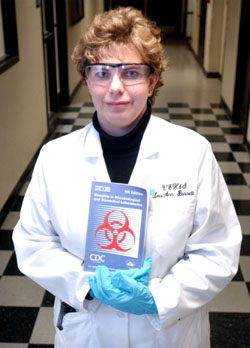
LouAnn Burnett of Environmental Health and Safety holds a biosafety manual and wears protective gear. (photo by Dana Johnson)
Vanderbilt officials move to protect hazardous agents
For the past two years Vanderbilt officials have been quietly developing a Web-based inventory of biological and chemical agents used by University and Medical Center researchers.
While the Web-based inventory model is still in a “beta testing” mode, Vanderbilt Environmental Health and Safety Biological Officer LouAnn Burnett says Vanderbilt is ahead of some research institutions in its tracking of agents that could be used as weapons of mass destruction and continues to compile an inventory of possible harmful agents stored at Vanderbilt.
You won’t find anthrax or smallpox on that list. Smallpox is kept at the Center for Diseases Control and Prevention (CDC) in Atlanta, and there are no Vanderbilt researchers currently using anthrax in any research projects.
“Despite the fact that there is no federal regulation for the possession or use of those materials, we have been compiling an inventory of biological and chemical agents,” Burnett said. “And we have long recognized the need for such an inventory—long before the threat of terrorism.”
Burnett added that while no federal regulation exists (except in the transportation and transfer of such agents), there are regulations from OSHA, the National Institute of Health and the CDC that control the appropriate use of microbes and chemicals.
The CDC has issued a list of “select agents” to university and research facilities that could have the potential to be used as weapons of mass destruction. The list includes viruses, bacteria, fungi and toxins. Vanderbilt has registered with the CDC to handle and use some of those select agents and currently has one agent registered.
“The security for that agent is very much like we have for controlled substances,” explained Bob Wheaton, director of Vanderbilt Environmental Health and Safety. “It is kept under lock and key, and a log is maintained on its use.”
Wheaton would not disclose the agent or its use due to security concerns. He said his department has been working with the Vanderbilt Research Enterprise group to disseminate information on the storage and security of biological and chemical agents.
“Life has changed forever since the Sept. 11 attacks,” Wheaton said. “I think in the future we will see a federal requirement of a background check on anyone who would use or have access to these agents. We will also see more stringent controls and reporting requirements.”
As part of the biosafety program, Wheaton said any select agents that are not registered with his office would be subject to collection and immediate disposal.
“It is imperative that we take steps to minimize the possibility that our tools for research can be turned against us as weapons of terror,” he explained. “But we have excellent cooperation with the research staff in making sure that our community is safe.”













